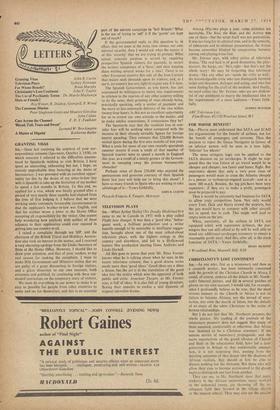TELEVISION PLAYS
SIR,—When Arthur Halley (No Deadly Medicine) first came to me in Canada in 1955 with a play called Flight Into Danger, it was then a 'good idea.' Subse- quent work, a brilliant production and a writer humble enough to' be amenable to intelligent sugges- tion, brought about one of the most talked-about television plays, with the highest ratings in this country and elsewhere, and led to a Hollywood feature film production 'starring Dana Andrews and Linda Darnell.
All this goes to prove that your Mr. Peter Forster knows what he is talking about when he says, in his recent television column, that a good drama series needs more than 'good ideas.' Good ideas are a dime a dozen, but the art is in the translation of the good idea into the reality which wins the approval of both public and critic. Armchair Theatre, as Mr. Forster says, is full of ideas. It is also full of young directors, flexing their muscles to evolve a real dynamic of original television drama. Among fifty-two plays a year, some, mistakes are inevitable. The Bird, the Bear, and the Actress was one of them—but the script itself was not pretentious. It was too long for its allotted time, and in the tensions, of rehearsals and its ultimata presentation, the drama became somewhat blunted by compromise between cutting and playing it too fast.
Mr. Forster says, with other critics of television drama, 'The real lack is of good dramatists, the play- doctors, the hacks, etc.' He's right—but that's not the whole story! He may be forgetting that television drama—like any other art—needs the critic as well : the knowledgeable critic who can distinguish between script and direction, dialogue and acting, and who has some feeling for the craft of the medium. And finally, we need critics like Mr. Forster, who are not disdain- ful of our ambitions to marry the intellectual idea to the requirements of a mass audience.—Yours faith- fully, I•'ilm House, 421150 Wardour Street, WI






































 Previous page
Previous page